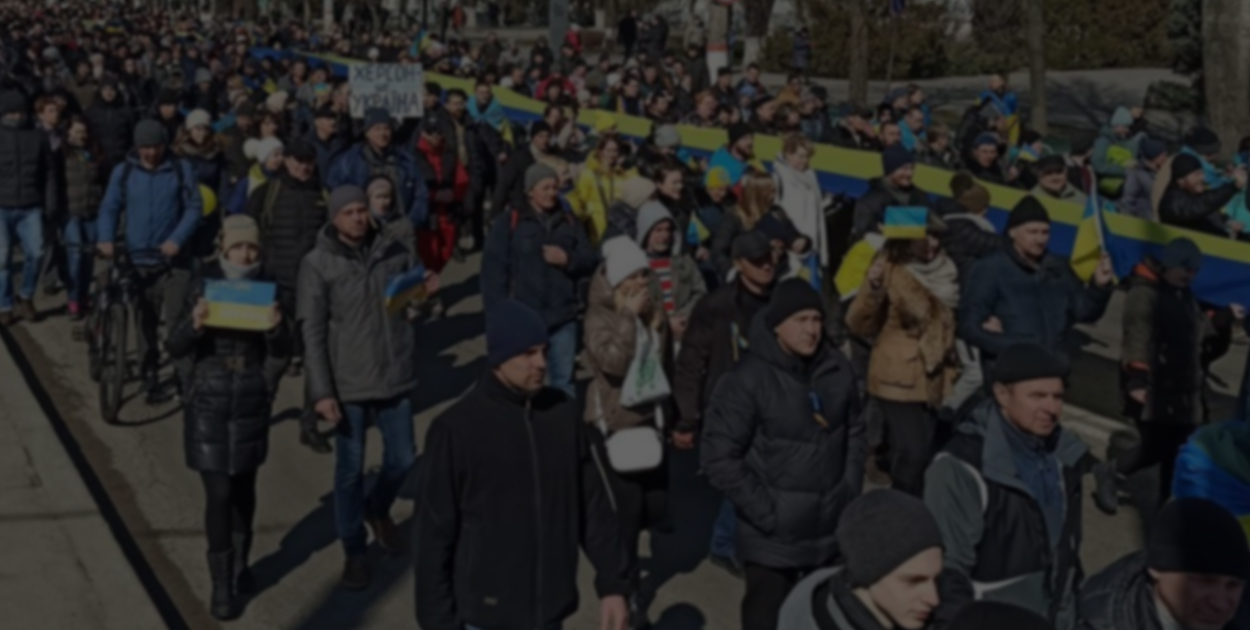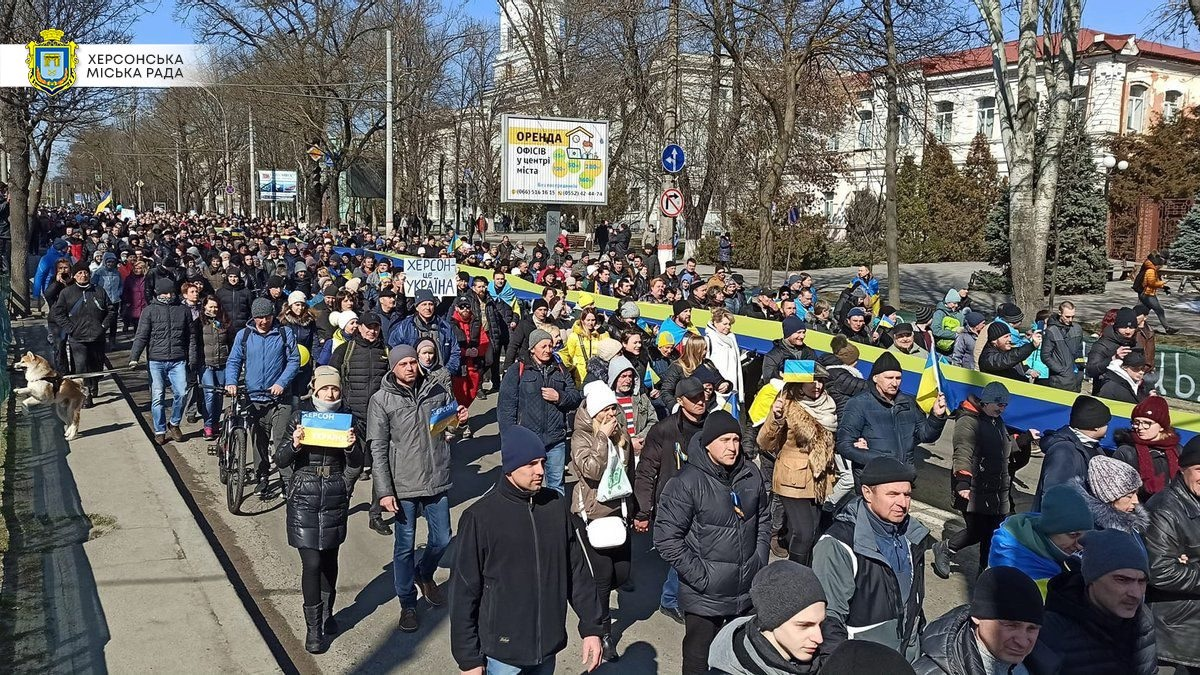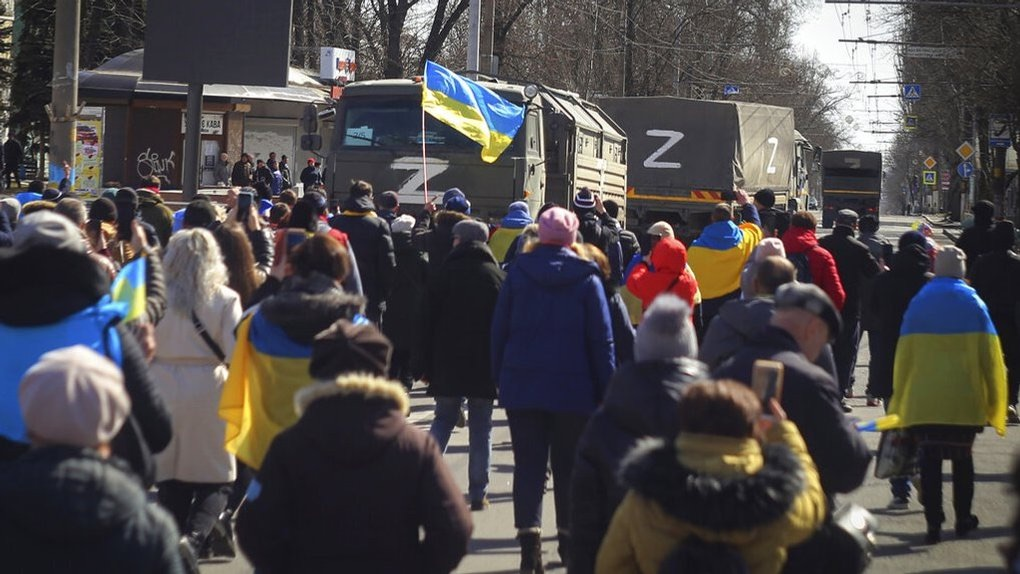Kherson in the first months of the full-scale war: a local's story about rallies, abductions and departure

On February 24, the Russian military occupied several large cities in southern Ukraine: Henichesk, Skadovsk, Oleshky, Kakhovka, Nova Kakhovka, Hola Prystan, and the Kakhovka hydroelectric power plant. On March 1, the Russian army began shelling Kherson and set up checkpoints around the city. During the attack on the city, Russians killed territorial defence fighters and seized the regional administration's building. The local administration worked until April 25 under the Ukrainian flag on the building until the Russian military came in. Despite the tanks and armed men, Kherson residents protested for two months until the Russian troops started kidnapping and killing people, taking them captive and shelling peaceful gatherings. Kherson is still under Russian occupation.
All this time, local activist Anton (name changed for security reasons) stayed in Kherson until he left in late May due to the danger to his life. We tell the story of his confrontation with the Russians, life under occupation and departure to the territory controlled by Ukraine.
Kherson beginning of the full-scale war
Anton had never seen such a crowd of people who came to a rally because of politics. On March 5, the man joined hundreds of Kherson residents on the central Freedom Square to show the Russians who came on tanks to "liberate" the south that they were not welcome there. It was to be the first mass rally of Kherson residents against the occupation. However, it all had started earlier - on February 24.
Anton’s wife woke him up and said they would not take their 4-year-old daughter to kindergarten. In Kherson, the guy worked as a journalist, so he spent the whole day on February 24 swiping the news, distracted by thoughts of where to buy water, what things to pack, and most importantly - whether to leave Kherson or not.
On February 25, Anton went to the military registration and enlistment office - there, he met only one employee who was burning documents. Anton calls this time a period of uncertainty: no one knew what to do and what was happening. It became more accessible when the local authorities returned to work, but they were only worried about public transport running on schedule and the streets being swept.
- The regional council - our governor Lahuta - disappeared on the first day, and a few months later, he reappeared saying that he was leading a guerrilla movement," Anton says ironically.
However, there was a movement - neither partisan nor pro-government. Locals were getting organised and helping hospitals: they felt the need to do something and change things. They also prepared for a meeting with the Russians: they collected glass bottles, poured gasoline into them and plugged them with a rag - made Molotov cocktails.
Immediately after the capture of Antonivskyi Bridge (one of the few crossings of the Dnipro River in the Kherson region), the Russian army tried to break through to Mykolaiv and from there to Odesa.
They got a kick in the teeth near Mykolaiv, so they returned, surrounded Kherson from all sides and entered the city on March 1. After that, it became unclear to everyone what would happen next.
The Russians did not know what to expect from the locals; the locals did not know how to react to the Russians. The former were armed with machine guns and had vehicles, and the latter clenched their fists and held gasoline bottles.
It became apparent when the Russian military started shooting at everything that moved: a woman, a child or a leaf on a tree.

Russian occupation and Ukrainian resistance
- Kherson's territorial defence tried to fight back: one group of fighters was in Buzkovyi Park, the other near the Fabrika shopping mall. Kherson's residents, at best, had assault rifles; most of them went against armoured vehicles with Molotov cocktails. Finally, all of them were defeated.
After that, the first few days, the Russians looked out for a shot from every window - they feared the response of the locals. In the end, Kherson residents came out to see what was happening because they did not understand whether they were under occupation: the Russians came in, captured key points for fighting, and set up checkpoints, but the Ukrainian flag was flying in the centre of Kherson.
- When people realised they could walk the streets, that Russians were there, but there was no contact with them, they felt the pressing tension and had to be released. We wanted to show that Kherson is Ukraine and that our city did not want to see the occupiers. How to show it if there was no way to shoot them? How to make it clear that the Russians must get out of here?" Anton says nervously as if he were still looking for an answer.
Kherson residents did their utmost: first, they prevented propagandists from shooting a video of Russians distributing humanitarian aid. There was already a car with the tricolour on the square. Russian journalists were talking about it on camera. Meanwhile, in the background, a crowd of people with Ukrainian flags was gradually growing. They wanted to show that they did not need help from Russia. It was March 4.
On the same day, Kherson film director Serhii Pavliuk called for a more massive rally, which took place on March 5.
- An incredible number of citizens came - I don't remember so many people who went to a political rally in Kherson.

Anton says it affected everyone: those who came out, those who watched from other cities, and the Russians themselves.
- They thought they came to save people. But, instead, they were told to get away. It was a shock. And we could not but go because hatred and anger were accumulating, and we had to release them somehow," the man waves his hands as if trying to show the size of his hate, but his arms do not fit into the screen.
It was the first mass rally in Kherson against the occupation. Later, similar actions took place almost every day. On March 13, Kherson residents again decided to come to the square en masse because of the symbolic date - the liberation of Kherson from the German invaders.
"The occupants wanted to put on a show and announce a pseudo-referendum on the accession or independence of the region. However, they did not know what to do when they saw us. It turned out that the people, who were supposed to cooperate with them, were only stealing the budget but could not help. So they decided to follow the protocols of 2014 - to announce a pseudo-referendum".
But, as Anton notes, Kherson in 2014 and 2022 are two different cities. Therefore, if in 2014 it was still possible to try to sway Kherson residents towards separatism and cooperation with Russia, in March 2022, the citizens protested and attempted to drive the Russians away.
Kherson residents went to meetings, lay down under the tanks, hung Ukrainian flags on the tanks and tried to push the equipment out of the city. And then they started shooting at them.
"Imagine: there is a large crowd with Ukrainian flags and posters "Putin is a f**k", "Zelensky well done", and "Glory to Ukraine". And the Russians are sitting in their vehicles and watching. I think they felt pressure, so they shot in the air and beat and kidnapped people. Then, at the end of March, they started using smoke grenades and beat people with batons to disperse the rally."
Despite this, the rallies continued. The organisation changed: no one took responsibility if something happened to someone. Some left, and others were kidnapped. Some are still missing, and some have been held captive for several months.
There are still many pro-Ukrainian people in Kherson, but they are hardly noticeable because they are hiding. Pro-Russian ones come out because it is safe for them. This way, the picture is made
The last pro-Ukrainian rally occurred at the end of April when the Russians planned to hold a pseudo-referendum again. About 100 Kherson residents came out against it. The Russians dispersed protesters again and curtailed the voting; on the square, they left a car shouting through a loudspeaker: "Citizens, the actions are FORBIDDEN".

34 checkpoints - and Ukraine
Anton and his family left for the territory controlled by Ukraine in late May. They stayed because there was still hope that the city would be liberated soon.
It was constantly in the information space: first, we had to hold out for three days, then ten, two weeks, a month. Finally, a month became a tipping point. We lived in hope, and then it became clear that there would be no quick release
It became dangerous for the activist and journalist, who had problems with local pro-Russian persons before the full-scale invasion, to stay in Kherson.
"In fact, there is no statehood there. I did not have the strength to withstand the occupation. In addition, we have a child: what if something happens to us? The events in Bucha also had an impact. We realised it was time to leave."
Since all roads but Vasylivka in the Zaporizhzhia region had already been blocked, Anton and his family went there. They passed 23 checkpoints from Kherson to Melitopol, another seven from Melitopol to Vasylivka, and four more in Vasylivka. Anton says that they drove "quite quickly - in just two days". Before the full-scale war, the journey took an hour.
There was no filtration per se: they just checked the phone. Anton believes that they were lucky.
Nowadays, the family lives in Kyiv, and Anton himself continues to work with information: he writes texts for the publication he used to work for and cooperates with the project Archive of War launched by Docudays UA. The man is the coordinator of data collection, processing and uploading to the service; he sorts, uploads to the archive and makes the initial description of the materials sent by people, transferred by partners and created by the project staff.
Why was the Archive of War created? Several reasons: to file lawsuits in international courts; to restore events; to be used in artists' works to reflect on events.
"It's all about comprehension and preservation of memory, including understanding how it happened and preventing it from happening again. And I watch these videos. Sometimes I see familiar faces."
Anton did not expect to experience those events again through the archive. However, he says that whenever he watches a video or a photo, he feels hatred and a desire to change something with his activity to convey information further, so that memory of those events doesn’t go blank.
So that my daughter understands what Russia is.


